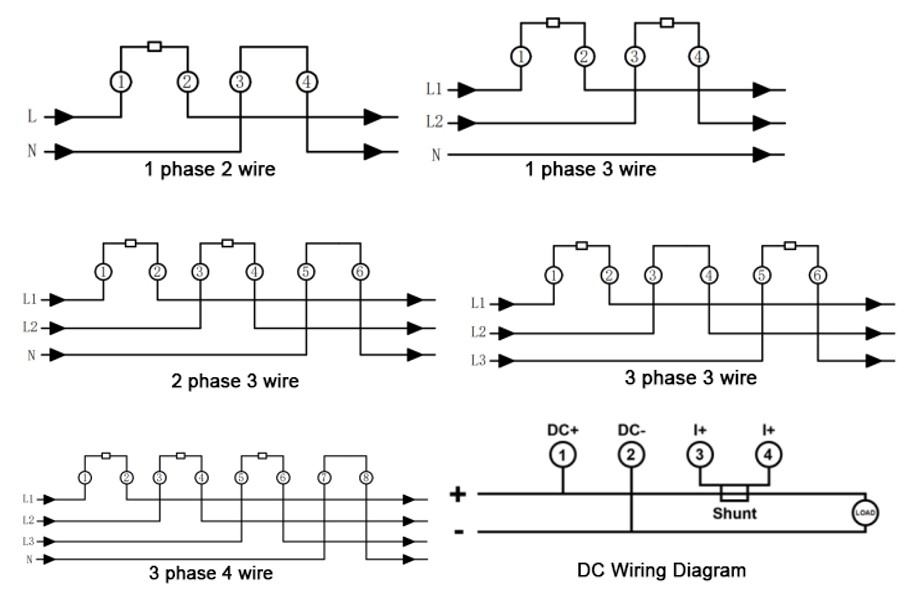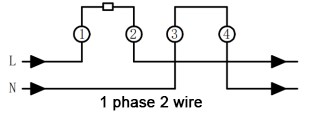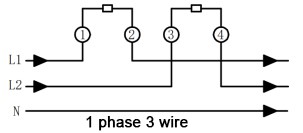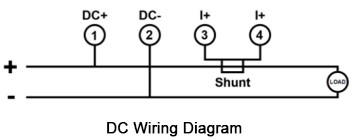
5 Types of Electric Energy Meters Based on Power Supply Methods
Electric energy meters are instruments used to measure electric energy, also known as an electric watt-hour meter, a fire meter, or kilowatt-hour meter.
Electric energy metering is an important link in the production and operation activities of electric power enterprises and the safe operation of power grids. Trade settlement and assessment of economic and technical indicators of the power system must rely on accurate and complete electric energy metering devices. The performance and management level of electric energy meters are not only related to the development of the electric power industry and the image of electric power enterprises, but also affect the accuracy and fairness of trade settlement, and involve the fundamental interests of the majority of electric power customers.
For ordinary people, electric energy meters are both familiar and unfamiliar. They all know that electric energy meters are useful in their homes, but most people have never cared about these electric energy meters. There are many types of energy meters, and different countries and regions have their own requirements.
This article will introduce the types of energy meters from the perspective of power supply methods.
5 Types of Energy Meters by Power Supply
Type 1: Single-phase two-wire watt-hour meter, referred to as single-phase watt-hour meter (220V or 110V), live line L, neutral line N, the voltage between live line and neutral line is 220V~230V in 4/5 countries in the world, and 110V in some countries, such as the United States and Japan. Single-phase electric energy meters are used to measure and charge electricity for residential users. It has a large volume and a wide range, which is directly related to the interests of thousands of households, and is also related to the stable and safe operation of the power sector.

Type 2: Single-phase three-wire watt-hour meter (120/240V), 2 live wires L, 1 neutral wire N, 120V between the neutral wire and the live wire, and 240V between the live wire and the live wire; Philippines, Japan, and Taiwan all use single-phase three-wire Energy Meter.

Type 3: Two-phase three-wire watt-hour meter (2*120/208V), 2 live wires, 1 neutral wire, 120V between the neutral wire and the live wire, and 208V between the live wire and the live wire; South America will use a two-phase three-wire watt-hour meter.

Type 4: Three-phase three-wire watt-hour meter (3*100V), 3 live wires without neutral wire, delta connection, 100V between live wires, used for power generation, transmission, and the high voltage side of power transformation. PT and CT are required for use.

Type 5: Three-phase four-wire watt-hour meter, referred to as a single-phase watt-hour meter (3*220/380V), 3 live wires, 1 neutral wire, star connection, 220V between the neutral wire and the live wire, 380V between the live wire and the live wire; It is mostly used for industrial power consumption or large user power consumption.

Although the electric energy meter is small, it is a metering product related to people’s livelihood, so it has high requirements for it. With the advancement of science and technology, the manufacturing and design level of the electric energy meter has also been continuously improved. Various types of energy meters (prepaid, multi-rate), smart meters, etc., are to meet the growing market demand.
Types of Energy Meters by Other Methods
AC Energy Meters: The most commonly used type in industry, covering both single-phase and three-phase systems. Used to monitor the operating status of factory power distribution networks, transformers, and large motors. Blue Jay’s multifunction meter, din rail meter, multichannel energy meter, and digital panel meter are this type of energy meter.
DC energy meters are mostly used in new energy power generation, telecommunication base stations, subways, DC charging piles, and other applications. With the development of new energy power generation and electric vehicles, the consumption of DC energy meters is also growing rapidly.

Multifunction Power Meters: Mainstream industrial products. In addition to electricity, they can measure voltage, current, active/reactive power, power factor, frequency, and other electrical parameters in real time. Blue Jay can offer this type of electric meter for any needs.
Power Quality meters: High-end types of energy meters. They not only measure parameters but also capture harmonics (THD), voltage fluctuations, flicker, and three-phase imbalance, among other things, to protect sensitive equipment and troubleshoot power grid faults. Now we only have APM-96Q for you.
Single-channel Meters: Monitor a single circuit (such as a single motor or a workshop).
Multi-channel Meters: A single meter can simultaneously monitor 12, 24, or even more single-phase circuits or multiple three-phase circuits. Blue Jay can offer up to a 24-channel energy meter for you.
DIN Rail Mount Meters: Compact in size, they are directly mounted on a rail inside the distribution box. Suitable for distribution cabinets with limited space and dense circuits. Our DEM series is 35mm DIN rail-mounted meters.
Panel Mount Meter: Installed on the switch cabinet door. The front panel is equipped with a display screen and buttons, allowing maintenance personnel to directly observe data and perform on-site debugging. Our BPM series and APM series are panel-mounted.
RS485 Modbus-RTU Energy Meter: Industry-standard wired communication. All our energy meters are RS-485 by default.
Ethernet Energy Meter: Uses a standard RJ45 interface and supports protocols such as Modbus-TCP or HTTP/MQTT. You need to tell us before ordering.
Wireless energy meter: This type of energy meter’s communication includes WiFi, LoRaWAN, 4G/5G, and NB-IoT. Suitable for applications where wiring is not feasible, upgrades to older facilities, or remote smart energy monitoring platforms. This type of energy meter needs to be customized to your needs.
TOU (Time-of-Use) Meter: A smart meter that measures electricity consumption based on different time periods (e.g., peak, off-peak, and valley periods). It aims to help users significantly reduce electricity costs by optimizing electricity usage time (e.g., operating high-energy-consuming equipment during low-price periods) and assist the power grid in peak shaving and valley filling. Most of our meters are equipped with this TOU function.
CT energy meter: This instrument measures high currents by connecting an external current transformer (CT), and is specifically designed for industrial scenarios where the current exceeds the meter’s direct carrying capacity. It can proportionally convert high currents into small signals for safe measurement, enabling precise monitoring of large equipment or main power distribution circuits.
Dual-source energy meters are instruments specifically designed to simultaneously monitor two independent power inputs (such as AC mains and generator, or main power and backup power). They can measure the energy consumption parameters of both power sources separately on a single device, making them ideal for critical power-consuming locations such as data centers and hospitals, where power reliability is extremely important.
Related Articles:
7 Things About Din Rail Meter You Must Know
Electric energy meters are instruments used to measure electric energy, also known as an electric watt-hour meter, a fire meter, or kilowatt-hour meter.
Electric energy metering is an important link in the production and operation activities of electric power enterprises and the safe operation of power grids. Trade settlement and assessment of economic and technical indicators of the power system must rely on accurate and complete electric energy metering devices. The performance and management level of electric energy meters are not only related to the development of the electric power industry and the image of electric power enterprises, but also affect the accuracy and fairness of trade settlement, and involve the fundamental interests of the majority of electric power customers.
For ordinary people, electric energy meters are both familiar and unfamiliar. They all know that electric energy meters are useful in their homes, but most people have never cared about these electric energy meters. There are many types of energy meters, and different countries and regions have their own requirements.
This article will introduce the types of energy meters from the perspective of power supply methods.
5 Types of Energy Meters by Power Supply
Type 1: Single-phase two-wire watt-hour meter, referred to as single-phase watt-hour meter (220V or 110V), live line L, neutral line N, the voltage between live line and neutral line is 220V~230V in 4/5 countries in the world, and 110V in some countries, such as the United States and Japan. Single-phase electric energy meters are used to measure and charge electricity for residential users. It has a large volume and a wide range, which is directly related to the interests of thousands of households, and is also related to the stable and safe operation of the power sector.

Type 2: Single-phase three-wire watt-hour meter (120/240V), 2 live wires L, 1 neutral wire N, 120V between the neutral wire and the live wire, and 240V between the live wire and the live wire; Philippines, Japan, and Taiwan all use single-phase three-wire Energy Meter.

Type 3: Two-phase three-wire watt-hour meter (2*120/208V), 2 live wires, 1 neutral wire, 120V between the neutral wire and the live wire, and 208V between the live wire and the live wire; South America will use a two-phase three-wire watt-hour meter.

Type 4: Three-phase three-wire watt-hour meter (3*100V), 3 live wires without neutral wire, delta connection, 100V between live wires, used for power generation, transmission, and the high voltage side of power transformation. PT and CT are required for use.

Type 5: Three-phase four-wire watt-hour meter, referred to as a single-phase watt-hour meter (3*220/380V), 3 live wires, 1 neutral wire, star connection, 220V between the neutral wire and the live wire, 380V between the live wire and the live wire; It is mostly used for industrial power consumption or large user power consumption.

Although the electric energy meter is small, it is a metering product related to people’s livelihood, so it has high requirements for it. With the advancement of science and technology, the manufacturing and design level of the electric energy meter has also been continuously improved. Various types of energy meters (prepaid, multi-rate), smart meters, etc., are to meet the growing market demand.
Types of Energy Meters by Other Methods
AC Energy Meters: The most commonly used type in industry, covering both single-phase and three-phase systems. Used to monitor the operating status of factory power distribution networks, transformers, and large motors. Blue Jay’s multifunction meter, din rail meter, multichannel energy meter, and digital panel meter are this type of energy meter.
DC energy meters are mostly used in new energy power generation, telecommunication base stations, subways, DC charging piles, and other applications. With the development of new energy power generation and electric vehicles, the consumption of DC energy meters is also growing rapidly.

Multifunction Power Meters: Mainstream industrial products. In addition to electricity, they can measure voltage, current, active/reactive power, power factor, frequency, and other electrical parameters in real time. Blue Jay can offer this type of electric meter for any needs.
Power Quality meters: High-end types of energy meters. They not only measure parameters but also capture harmonics (THD), voltage fluctuations, flicker, and three-phase imbalance, among other things, to protect sensitive equipment and troubleshoot power grid faults. Now we only have APM-96Q for you.
Single-channel Meters: Monitor a single circuit (such as a single motor or a workshop).
Multi-channel Meters: A single meter can simultaneously monitor 12, 24, or even more single-phase circuits or multiple three-phase circuits. Blue Jay can offer up to a 24-channel energy meter for you.
DIN Rail Mount Meters: Compact in size, they are directly mounted on a rail inside the distribution box. Suitable for distribution cabinets with limited space and dense circuits. Our DEM series is 35mm DIN rail-mounted meters.
Panel Mount Meter: Installed on the switch cabinet door. The front panel is equipped with a display screen and buttons, allowing maintenance personnel to directly observe data and perform on-site debugging. Our BPM series and APM series are panel-mounted.
RS485 Modbus-RTU Energy Meter: Industry-standard wired communication. All our energy meters are RS-485 by default.
Ethernet Energy Meter: Uses a standard RJ45 interface and supports protocols such as Modbus-TCP or HTTP/MQTT. You need to tell us before ordering.
Wireless energy meter: This type of energy meter’s communication includes WiFi, LoRaWAN, 4G/5G, and NB-IoT. Suitable for applications where wiring is not feasible, upgrades to older facilities, or remote smart energy monitoring platforms. This type of energy meter needs to be customized to your needs.
TOU (Time-of-Use) Meter: A smart meter that measures electricity consumption based on different time periods (e.g., peak, off-peak, and valley periods). It aims to help users significantly reduce electricity costs by optimizing electricity usage time (e.g., operating high-energy-consuming equipment during low-price periods) and assist the power grid in peak shaving and valley filling. Most of our meters are equipped with this TOU function.
CT energy meter: This instrument measures high currents by connecting an external current transformer (CT), and is specifically designed for industrial scenarios where the current exceeds the meter’s direct carrying capacity. It can proportionally convert high currents into small signals for safe measurement, enabling precise monitoring of large equipment or main power distribution circuits.
Dual-source energy meters are instruments specifically designed to simultaneously monitor two independent power inputs (such as AC mains and generator, or main power and backup power). They can measure the energy consumption parameters of both power sources separately on a single device, making them ideal for critical power-consuming locations such as data centers and hospitals, where power reliability is extremely important.
Related Articles:
7 Things About Din Rail Meter You Must Know




